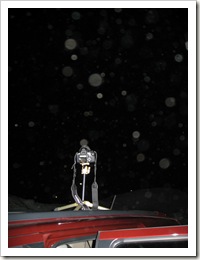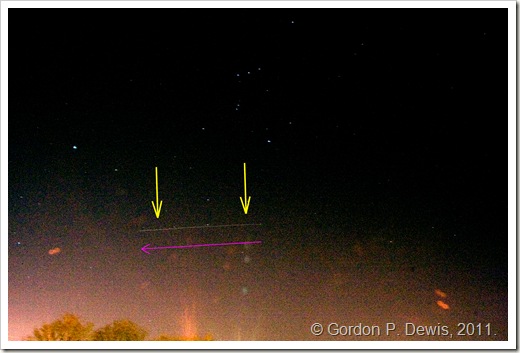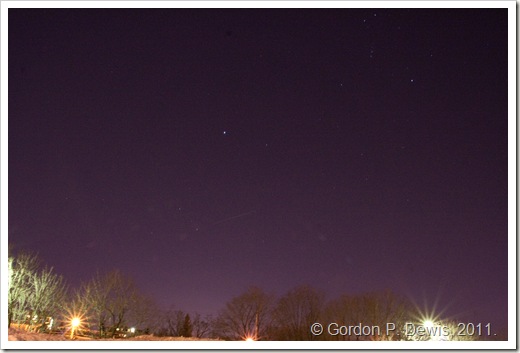Pictures of the ISS from Tuesday evening
Yesterday, I posted a short video I took of the ISS passing over Ottawa this past Tuesday evening, so I thought I’d post a copy of long exposure photos that I took.
 I used my digital Canon Rebel on a tripod that I sat on the roof of my SUV. Generally, I had the ISO set to 1600, stopped the lens down to about f/20 and manually selected a 30 second exposure. The autofocus was turned off and I manually set the focus to ~infinity and confirmed it the stars were in focus with some test shots. I have a small wireless remote that I used to trigger the shutter. To avoid condensation problems, I set things up about half an hour before the pass to allow the camera to cool down.
I used my digital Canon Rebel on a tripod that I sat on the roof of my SUV. Generally, I had the ISO set to 1600, stopped the lens down to about f/20 and manually selected a 30 second exposure. The autofocus was turned off and I manually set the focus to ~infinity and confirmed it the stars were in focus with some test shots. I have a small wireless remote that I used to trigger the shutter. To avoid condensation problems, I set things up about half an hour before the pass to allow the camera to cool down.
This is a 30-second exposure taken near the maximum elevation of the pass, looking to the southwest. One problem with long exposures and digital cameras is that the sensors can be saturated, making it hard or impossible to retrieve the information. Fortunately, I didn’t have this problem and a little processing made the trail stand out nicely. In real life, both the shuttle and ISS were quite bright relative to everything else in the sky.
I’ve indicated the direction of travel with the magenta arrow. The red smudges near the bottom of the image are from light along a walking path that’s just out of frame.
The second photo is the unprocessed version of the third image. If you look closely, you can see the faint trail about a third of the way up from the bottom, below the bright star in the middle of the image. If you look very closely, you’ll see a bright dot at the left end of the trail. This dot is the International Space Station.
Here is the enhanced version of the photo above:





 AKA Keeper of Maps, I'm a geocacher who lives in Ottawa, Canada.
AKA Keeper of Maps, I'm a geocacher who lives in Ottawa, Canada.

Why stop down so far? ISO 100, f5.6 gives you a 30 second exposure too with less sensor noise (both chrominance and luminance). As well, at f20 because of the rebel’s sensor size you will have diffraction issues which also degrades the image sharpness.
If it hadn’t been quite so cold, I might have done some experimentation. The pass only lasted a couple of minutes so I decided to go with this combination, which has worked for me in the past.
One problem I had were the trillion watt lights that were either just out of frame or in frame (depending on which direction I was facing). I had some creative solutions for that problem, but I didn’t think I could convince the guy pushing snow around with his front-end loader to help me out.
Yeah the light polution in the city makes any image involving stars difficult. One way of over coming this is stacking multiple images. However unless you are using software this can be a pain to do manually because of the earth rotation. I have only bothered to do it once:
http://www.flickr.com/photos/tyner/1317995132/
That’s a great photo! I haven’t tried stacking star shots, but I’d think with some creative masking one would be able to align the stars fairly easily.
I took the my photos from Yarrow Street in Tunney’s Pasture. Close to home and a decent view of the sky to the south and west. The downside is are the lights near the Transitway station. There’s not a lot traffic in the evening, so you don’t have to worry about headlights.